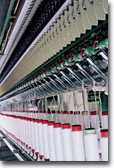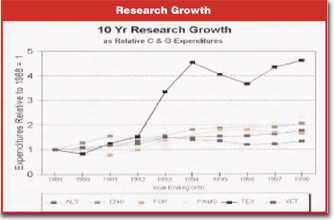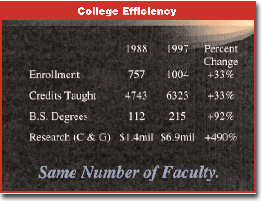A
s the textile industry in the South expanded during the late 1800s, a number of
industrial spokesmen in the various states requested programs to educate their managers and
workers.
The Clarkson Bill, presented to the General Assembly of North Carolina on February 8, 1899,
proposed establishing a textile school as a part of the Agricultural and Mechanical College in
Raleigh.
By the end of the 19th century, “there are over 225 manufacturing plants employing at least
30,000 operators, over one million spindles and about 25,000 looms, representing about $25 million
of investments,” said Judge Heriot Clarkson, then a newly elected representative from Charlotte,
who authored the bill. At that time, cotton was king and contributed mightily to the economy.
The bill was initially defeated, but in spite of that, the trustees of the Agricultural and
Mechanical College, meeting on March 13, 1899, appointed a Textile Education Committee, which in
turn hired George Franks Ivey, the first instructor in the newly estabilished curriculum of Textile
Industry.
From those humble beginnings grew N.C. State College of Textiles, one of the foremost
textile universities in the world.
“Textiles has always struggled for recognition from the establishment,” said Dr. Gary N.
Mock, professor and program director, Textile Engineering.
“Even though textiles was a major industry in North Carolina, and other states had
established textile education programs as a part of their colleges, North Carolina was the last of
the major Southern states to recognize textiles.”
The first students enrolled in the Fall of 1899 and joined the Engineering school to pursue
a bachelor’s degree in engineering, Textile Industry.
A four-year curriculum was devised, based heavily on math and science, with many hands-on
courses, such as carpenter shop, forge shop and steam engine. It was not until the junior year that
students took their first textile courses in cotton milling and cotton machinery. Textile chemistry
and dyeing was taught in the senior year.
Tompkins Hall
The first textile building was begun in the summer of 1901 on a site along Hillsborough
Street, just west of the main building. This two-story brick building — 125-feet long and 75-feet
wide — was a typical example of the standard construction used in cotton mills.
After the building was completed in 1902, the textile students installed the equipment under
the direction of mill employees. Funds for purchasing equipment were limited, but the machinery
builders were generous. Much of the original equipment was either donated by the manufacturers or
sold at considerable discount.
Enrollment in 1901 was 49 students. The first graduate was W.O. Bennett, who received a
bachelor’s degree in engineering, Textile Industry. Enrollment remained in the range of 25 to 53
students for the first 10 years, and 38 men had graduated by 1910.
On March 24, 1914, the building and equipment were almost completely destroyed by fire.
Insurance was found to be inadequate. The fire and lower enrollment (an average of 32 students from
1911-14) led college authorities to debate the wisdom of continuing the department.
Fortunately, the board of trustees decided to not only rebuild the structure, but to expand
it by adding 25 feet at the west end. This, plus re-equipping, was accomplished within a year.
World War I demanded a re-evaluation in the way the United States did business and the way
the colleges should prepare graduates. The Southern textile industry grew. Enrollment at the
college grew; 56 students in 1915, 113 in 1918 and 176 in 1921.
The board of trustees, meeting on July 8, 1925, removed the department from the School of
Engineering and created a Textile School. A three-story, 80-foot addition to the east end of
Tompkins Hall was completed in 1926. Extensive improvements were made and new equipment was added.
The experimental room was fully humidified to duplicate mill conditions, making the Textile School
the only institution in America with such facilities.
The Depression took its toll with decreased enrollment, but, incredibly, enrollment jumped
to 202 students in 1933, to 309 in 1934 and to 372 in 1937, as students realized that regardless of
the Depression, textile students got jobs.
“In the Depression years, the mandate from the Legislature was to consolidate,” Mock said.
“They asked for Dean Nelson’s resignation, and he became emeritus for a short time. Until,
that is, they realized that textile graduates were getting jobs. Suddenly, this old dean who
refused to change became the man of the hour. He was reinstated as dean and served another 10
years.”
Nelson Hall
The General Assembly of 1937 appropriated $15,000 for new equipment and $45,000 to enlarge
the building. It didn’t take long to realize this grant was completely inadequate. Added funds were
appropriated in 1938 to supplement a Public Works Administration grant of the U.S. Government to
build a new building.
After a long battle, a site was proposed in a pecan grove at the far west end of campus.
Textiles would be out on the fringe of the campus.
The plans called for a four-story, fire-proof, T-shaped building of concrete and steel,
containing 74,000 square feet — doubling the space from the twice-expanded Tompkins Hall.
Work began in January 1939. The building was dedicated on March 5, 1940, at a cost of $393,000
($600,000 with equipment), quite a hefty sum in 1940.
The N.C. Textile Foundation
In the early 1940s, it became evident that the College of Textiles was offering salaries
that were not competitive with those of industry and the department simply could not persuade
qualified people to teach. Raising money to find good teachers and administrators led to the
establishment of the North Carolina Textile Foundation (NCTF), made up of textile executives.
On December 31, 1942, the foundation was incorporated as a non-profit organization without
capital stock. Since then, it has remodeled and furnished the Textiles Library and the student
lounge, established the Shuttle Inn snack bar, sponsored professorships with endowed chairs, funded
scholarships, and supplemented salaries.
The number of returning students after World War II made expansion inevitable. Construction
began in September 1948, to attach an east and west wing to the rear of Nelson, including an
auditorium that seats over 500 students.
The Curriculum Evolves
When the first textile students were admitted in the fall of 1899, they joined the School of
Engineering and pursued a bachelor’s degree in engineering, Textile Industry.
The curriculum was heavily oriented toward hands-on laboratories and was short on theory.
Students spent a lot of time in shop, learning how to make castings and building wooden tools.
Research was emphasized, but only at the graduate level. The faculty wanted to continue
teaching undergraduates the same way they had been taught textiles. Shortly after World War II,
there were separate departments for Weaving, Knitting and Yarn Formation. Dean John Caldwell
pressed for a reduction in credits from 160 semester hours. The faculty resisted, insisting that
four-hour labs where students ran spinning frames or weaving machines for the whole lab were
critical.
Dame Hamby, dean from 1981-87, rewrote the curriculum by combining courses such as Cotton
Spinning, Wool Spinning and Synthetic Spinning into Yarn Manufacture I & II. Fabric Formation
was created in a similar manner.
The new curriculum stood at 141 credits. Later the curricula were reduced to 130 credits and
finally to today’s 124 credits.
“The creation of a Management program brought new life to the college,” said Mock.
“Spenser Love, chairman of Burlington Industries, was one of the leading proponents. The
focus over 100 years has been a shift from the mechanic arts to more emphasis on engineering and
technology.”
Centennial Campus
By 1980, the College of Textiles and its buildings were showing signs of age. The Nelson
Building had been built in 1939 and an addition added in 1949. David Clark Labs had been renovated
in the early 1960s. Equipment in the labs was falling apart and did not meet the needs of the
modern textile industry. Students were working on ancient, run-down equipment.
The champion this time was William Klopman, chairman of Burlington Industries. Informed of
the sorry state of affairs by Dame Hamby, Klopman persuaded Governor Jim Hunt to come to a meeting
in Nelson. On a tour after the meeting, they visited the Physical Testing Lab and the same table
where Mrs. Hunt had worked as a technician while husband Jim had been a student in the late 1950s.
Money and permission were granted to renovate Nelson, and just as plans were being
formulated, Governor Hunt donated nearly 1,000 acres of state land to N.C. State University. This
land is now called Centennial Campus. Chancellor Bruce Poulton insisted that a new College of
Textiles building be built on this campus. It was déjà vu all over again.
The new textile building would be on the campus fringe, this time in a kudzu field.
Construction began in 1988, and in January 1991, the huge 300,000-square-foot building on
five different levels, opened for students.
“It was a leap of faith by the faculty, staff and students,” said Robert A. Barnhardt, dean,
College of Textiles.
“We all wondered about our future in the kudzu jungle off Avent Ferry Road. N.C. State
leaders were developing a new vision for the university, and we were pioneers. New and larger
facilities, better-equipped classrooms and laboratories, a world-class model manufacturing
facility, and ample parking soon lessened our anxiety.
“Seven years later, the university’s vision is ever-expanding, and the College of Textiles
has reaped tremendous benefits from what has been described as the Centennial Campus Model.”
January 1999







